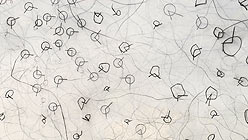She took three years of drawings, held in scholastic white and black speckled notebooks whose empty covers now lean on a gallery shelf. She mulched and recycled the work to create lumpy sheaths of paper. These pieces of paper do not serve as backgrounds to new drawings. Left blank, they are drawings — three years’ worth — stripped of their representational qualities and repurposed as physical material. Blue and black dashes of color show up in the weave of the new paper, the afterlife of crosshatching and shading, three years spent getting a Master of Fine Arts degree at the University of California, Berkeley. Contained in hard cover bindings, this collection by Renee Delores serves as a fitting greeting to These Canyons, the UC Berkeley MFA graduate exhibition, on view at the Berkeley Art Museum through Sunday, June 8, 2008.
As with Delores’s piece, each of the seven artists’ work is an archive of their time spent pursuing their degrees. And as with Delores’s, each body of work needs to be considered slowly, so that the layers of meaning come to the surface of their own accord. The exhibition’s layout is conducive to this sort of viewing. Unlike larger MFA programs, in which many worthwhile artists are necessarily displayed together in too-small spaces, the artists in this one aren’t on top of one another. There’s a message implicit in this floor-plan: take your time, the work needs and deserves it.
Indira Martina Moore’s large white canvases remind me of moonscapes. An intricate system of graphite dashes and dots, circles and lines create a gentle network of trails, directions, and off-center compass points. The tension between her attempts at navigating this white expanse and the unintelligibility of the mark-making system is exciting. The canvases are large — 60 by 84 in. — and the pencil lines are etched like skin cells into the white background. It is enough to just look at the canvases. Like windows that let in the sun, I just want to absorb them, not analyze them.
Rosalynn Khor’s film, In Your Hawaiian Way, is a commentary on the commodification of Hawaiian culture, presented in the form of a self-aware documentary of a tropical vacation. We watch Khor at her computer on the mainland, as she researches the Polynesian Cultural Center, clicking on the icon that allows her to chat with a “real Polynesian!” We go to the center itself, located on the island of Oahu; the camera lens positioned as the tourist gaze. From her vantage point as a visitor to the center, Khor films the awkward tour guide, dressed in sarong and flowered shirt, as he paddles a canoe full of tourists, confessing that it’s his first day and he’s still learning how to navigate the boat. “Aloooo-ha,” he greets the passengers exaggeratedly; it feels like parody.
My father grew up on Hawaii, and I remember visiting the Polynesian Cultural Center on one of our frequent trips to Oahu. I also remember my father sternly directing our family to make a U-turn shortly after entering the center, handing our still-good tickets to a family of “locals” walking through the parking lot. “It’s a tourist trap, it’s a joke,” he complained to us. Khor’s video successfully captures the theatricality of the Hawaiian tourist experience and the elusiveness of authentic Hawaiian culture, whatever and wherever that may be. Her filmmaking techniques mimic the tour guide’s failed performance of authenticity. Deliberately amateurish, her camerawork never creates a convincing fiction. Both performances have obvious holes that invite the viewer to consider all that has gone on behind the curtain.


